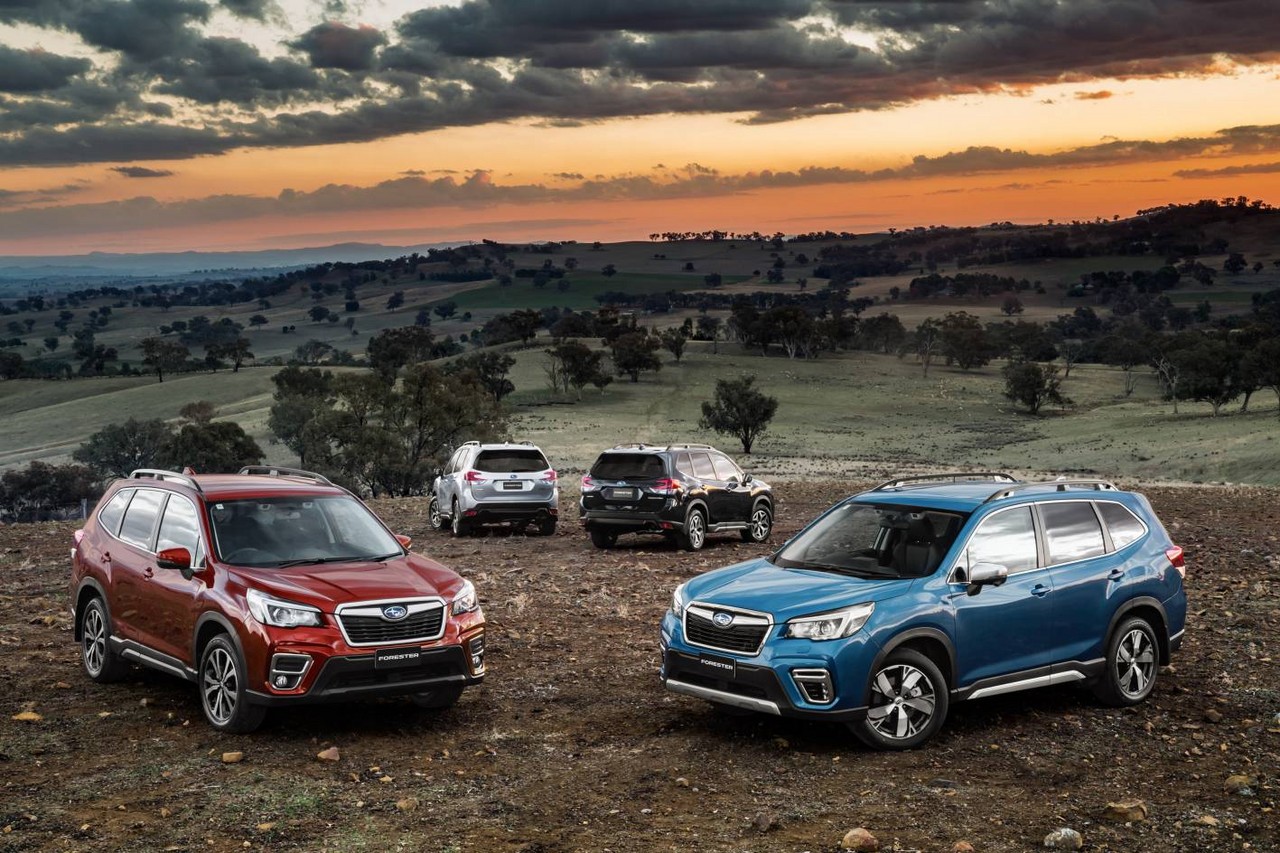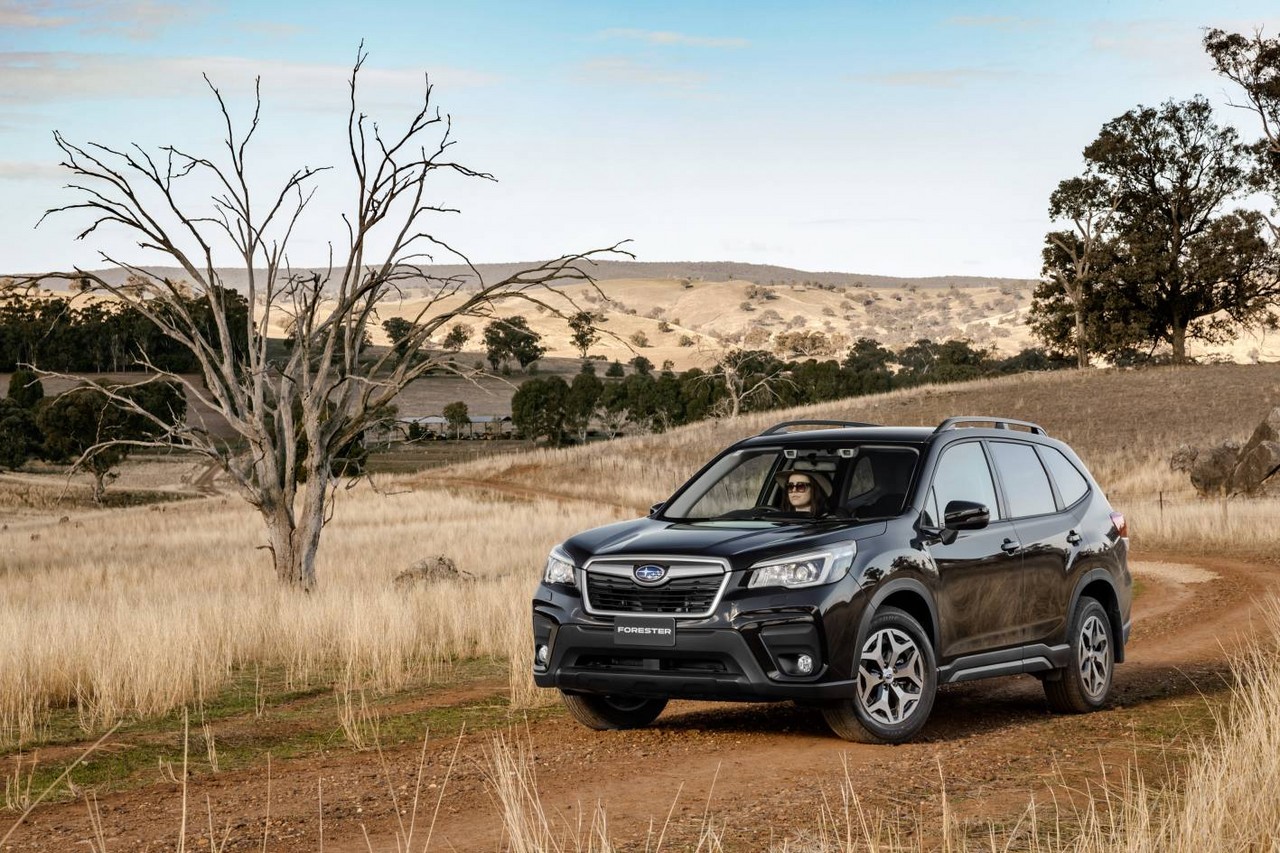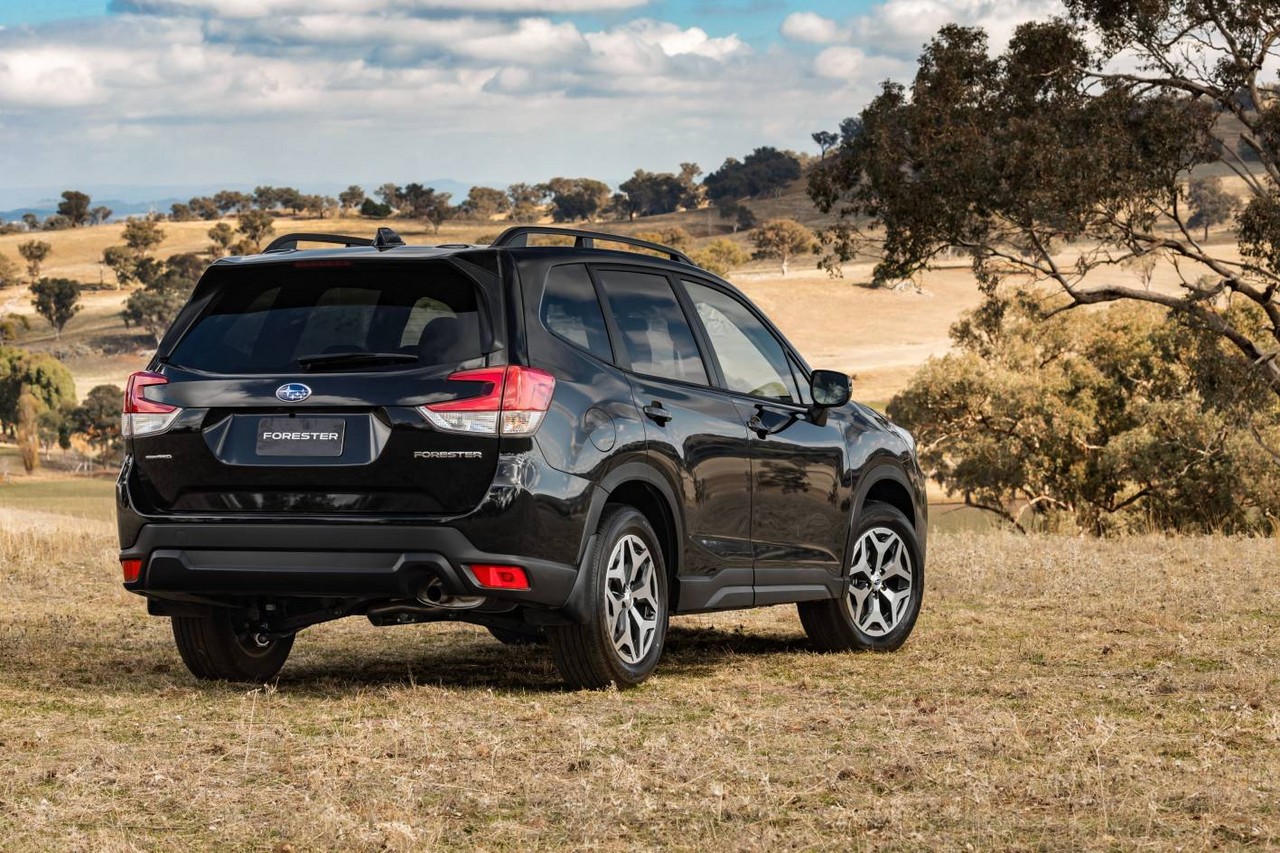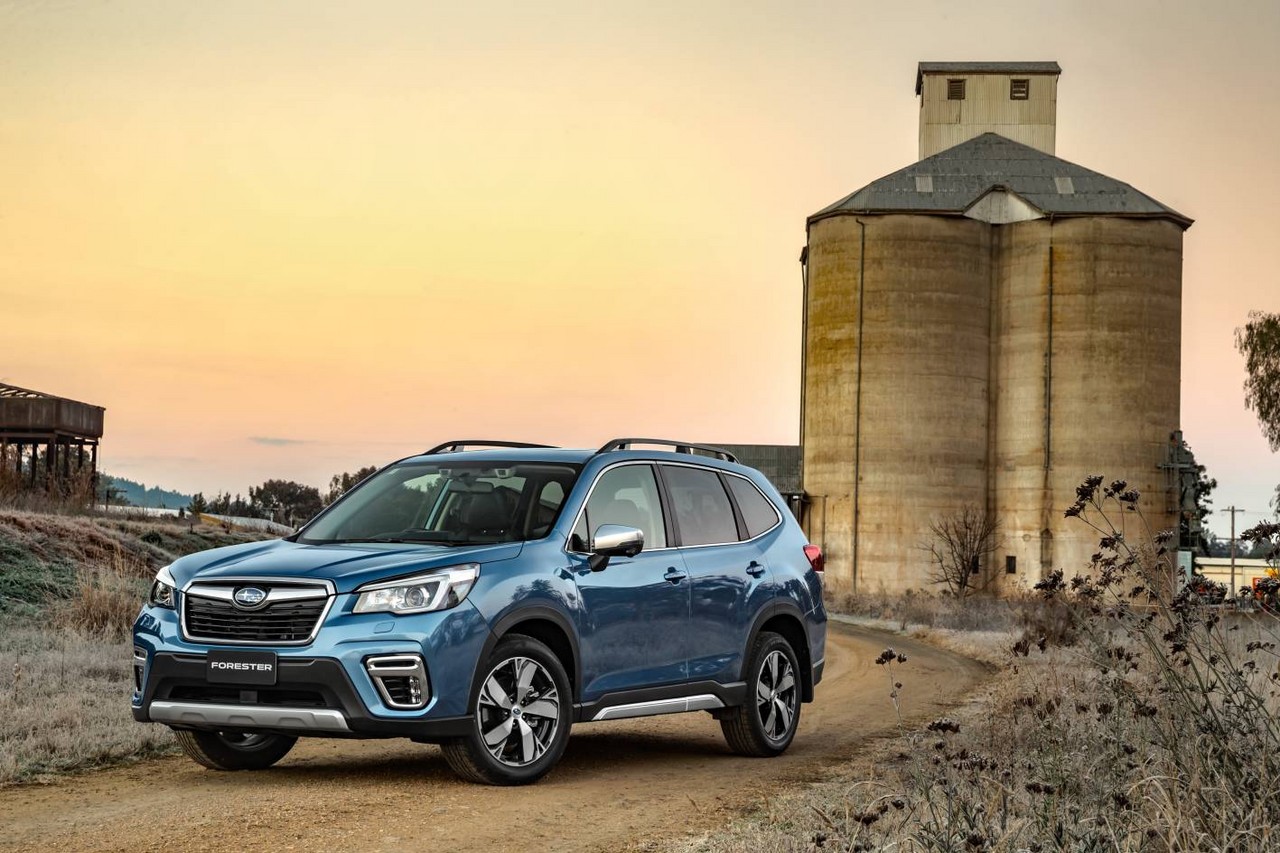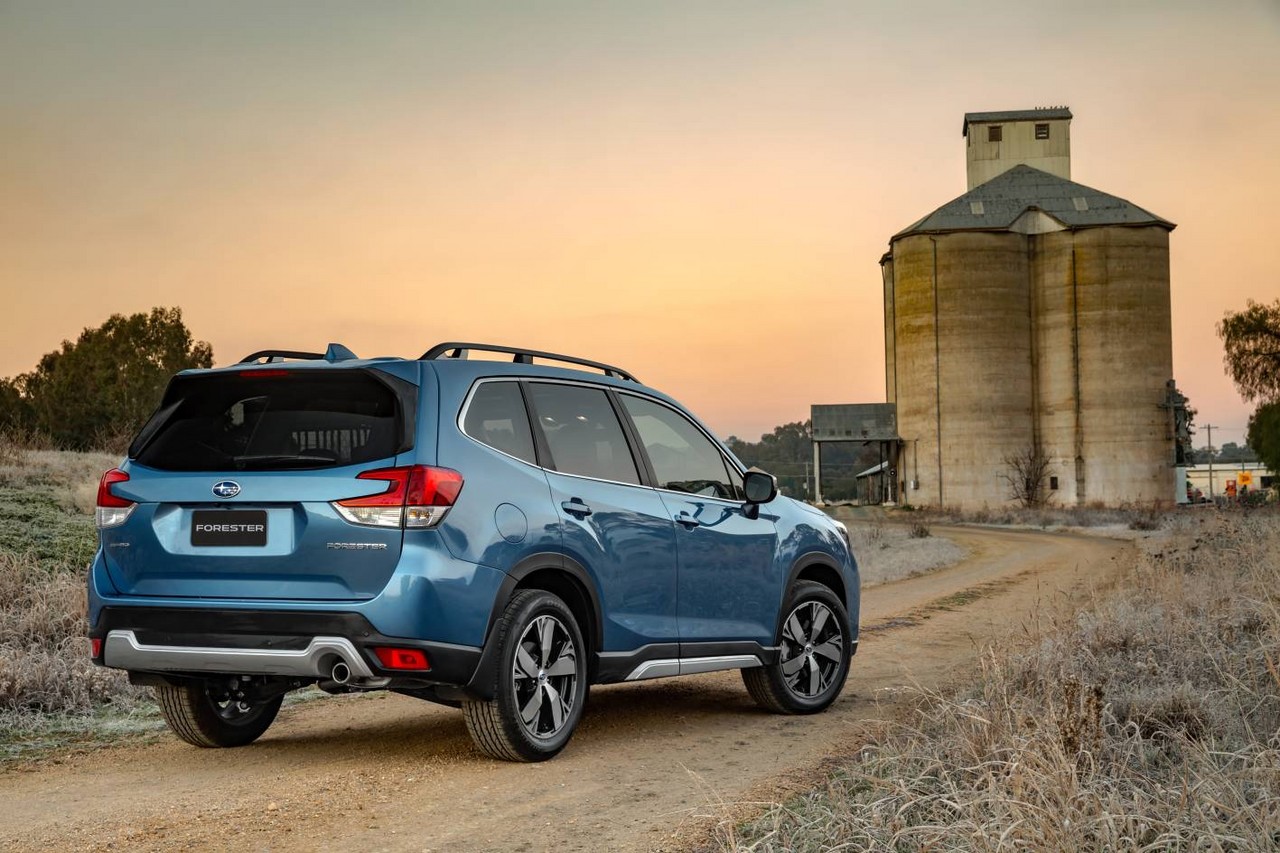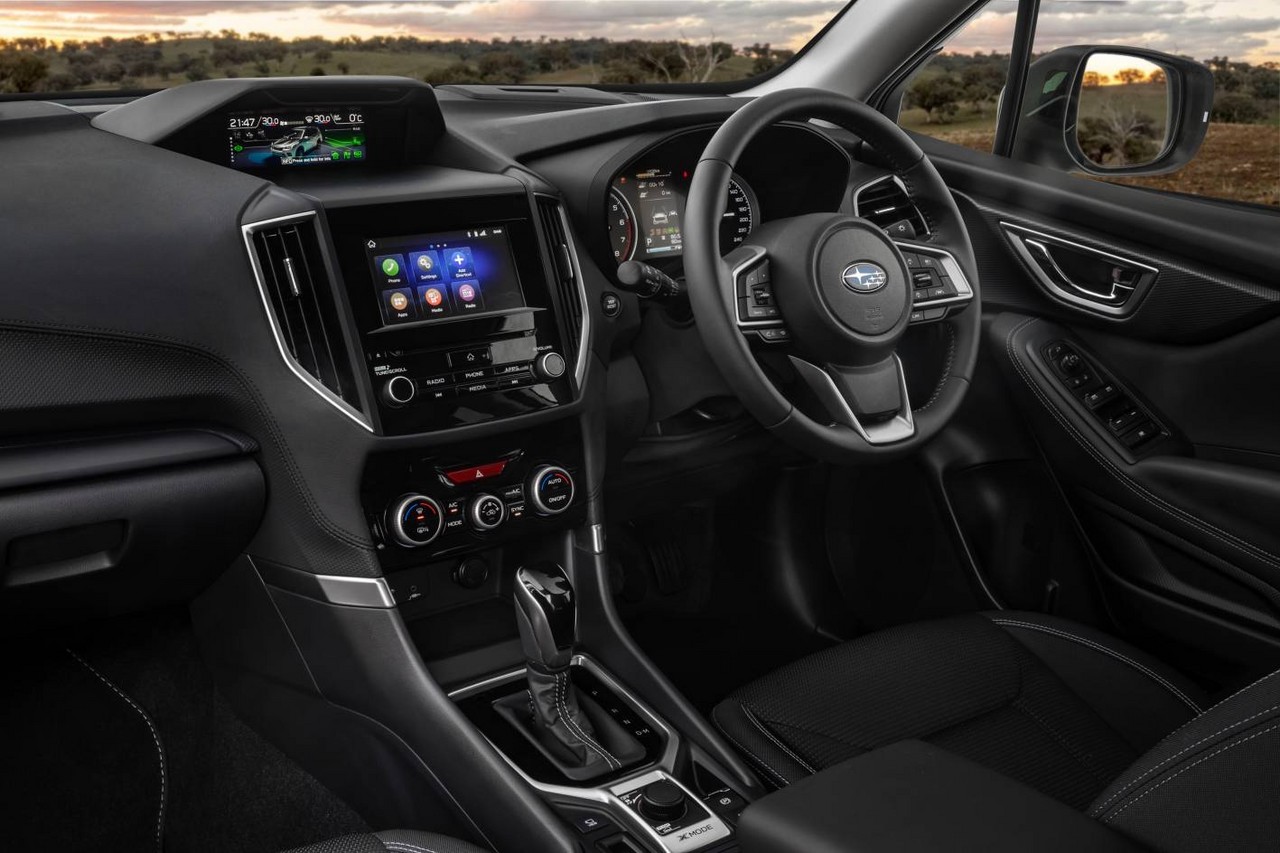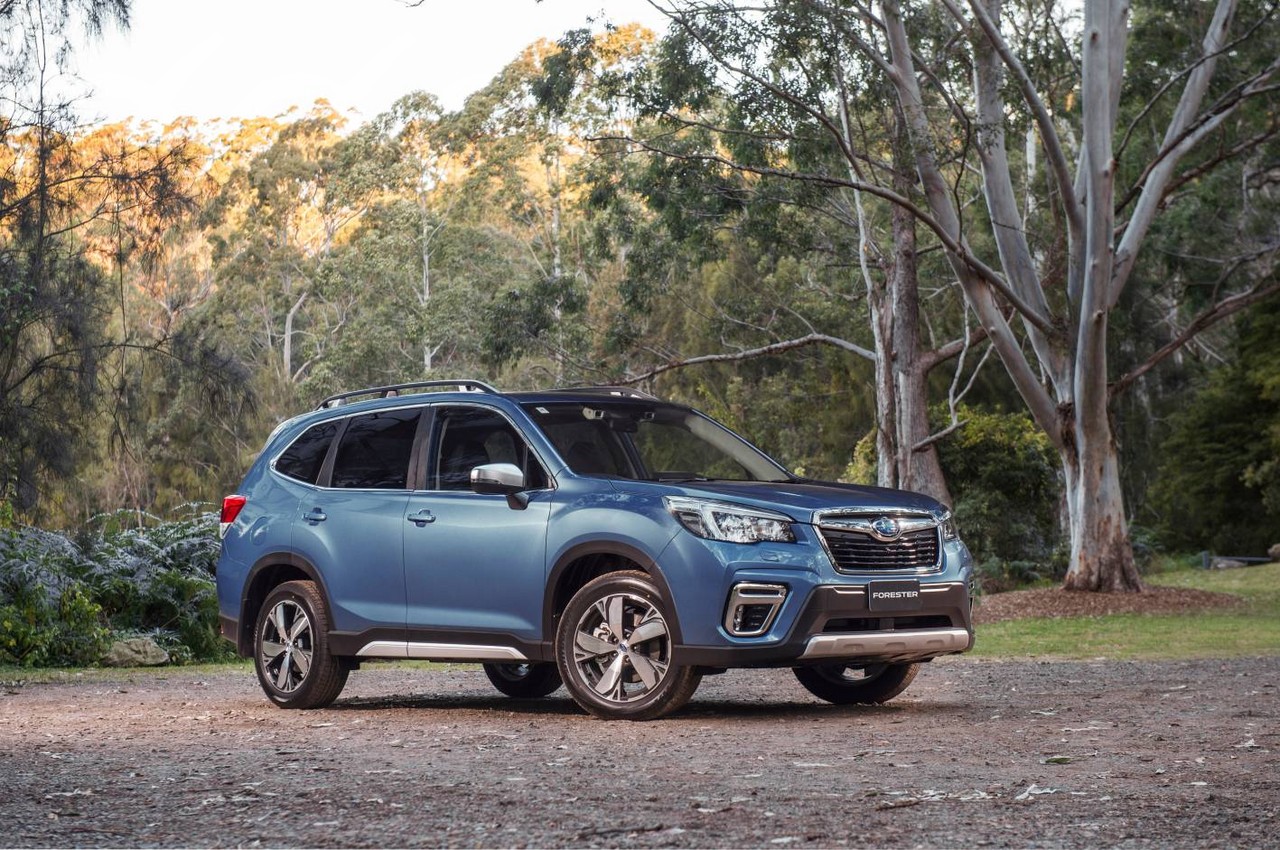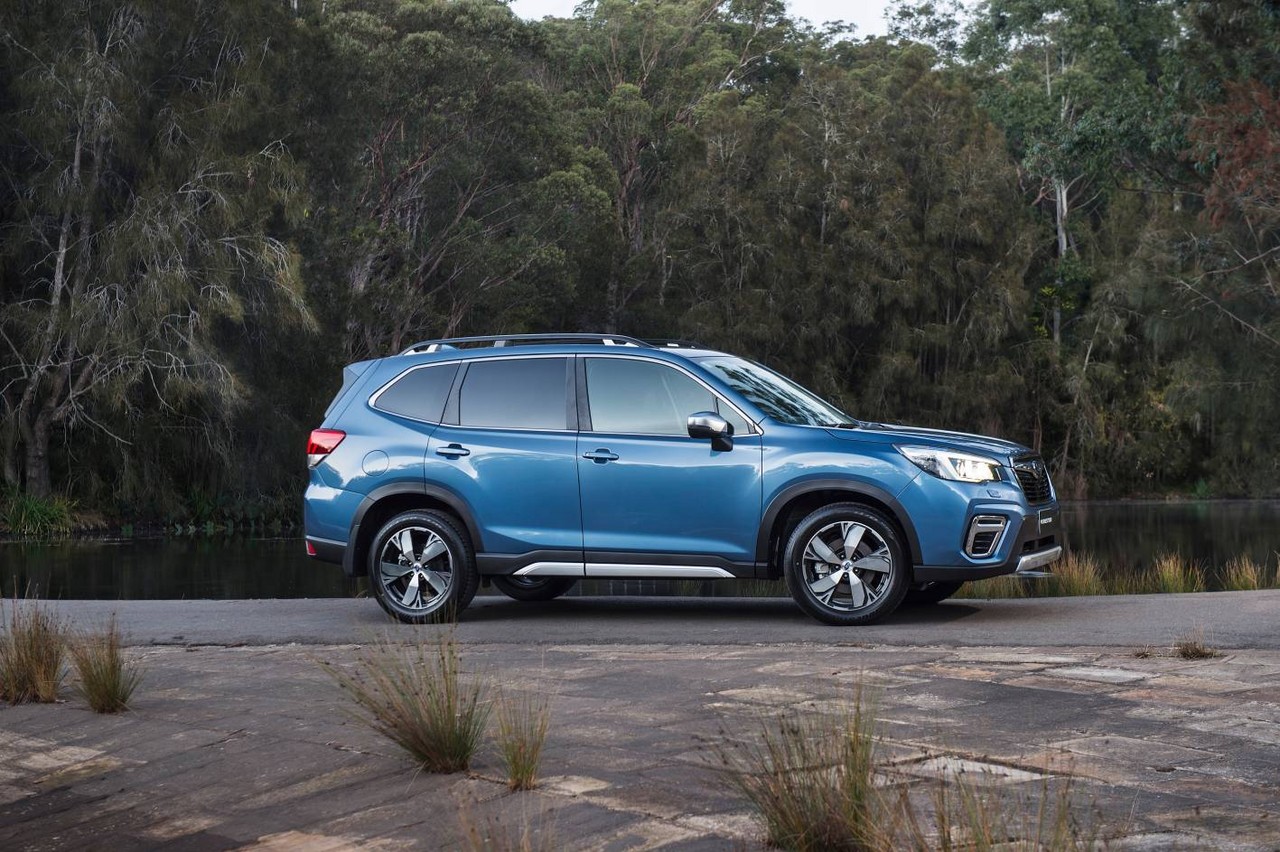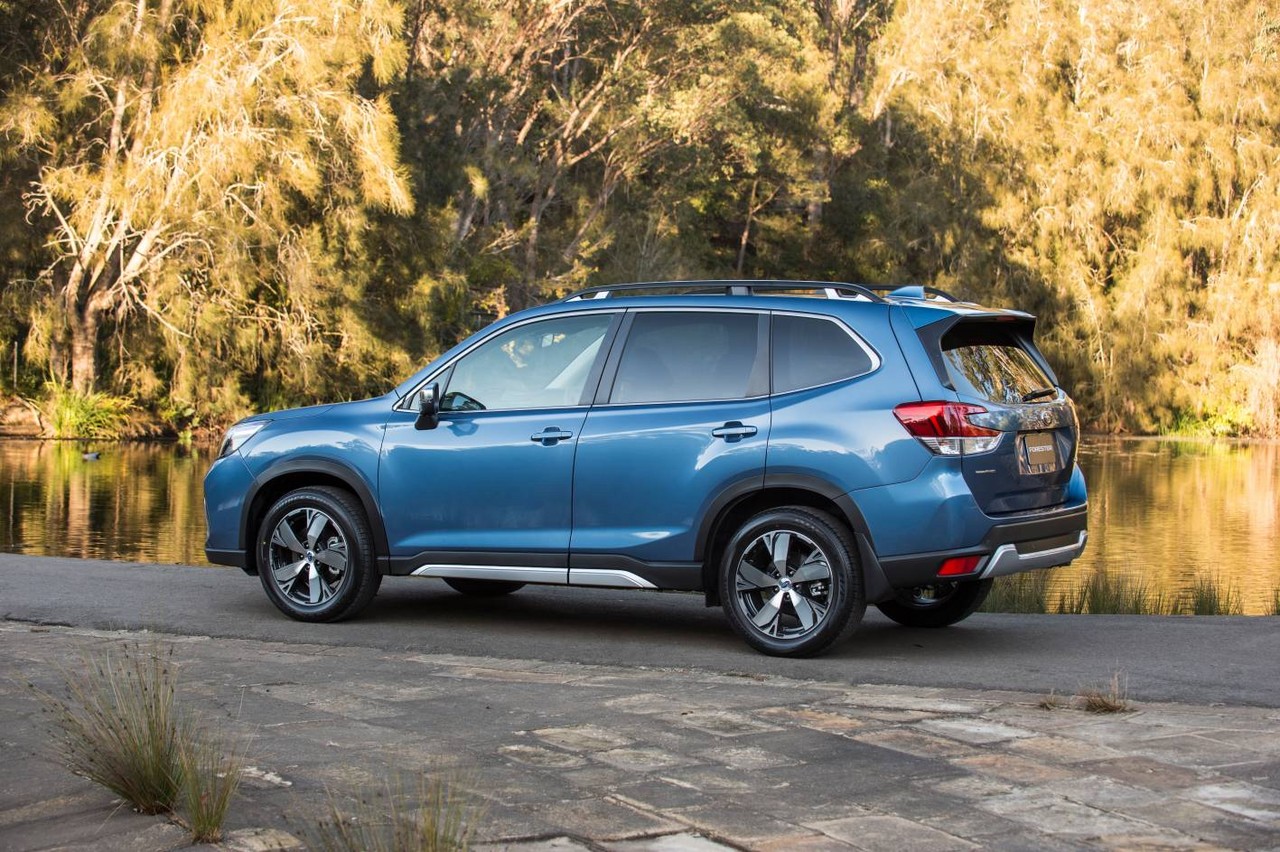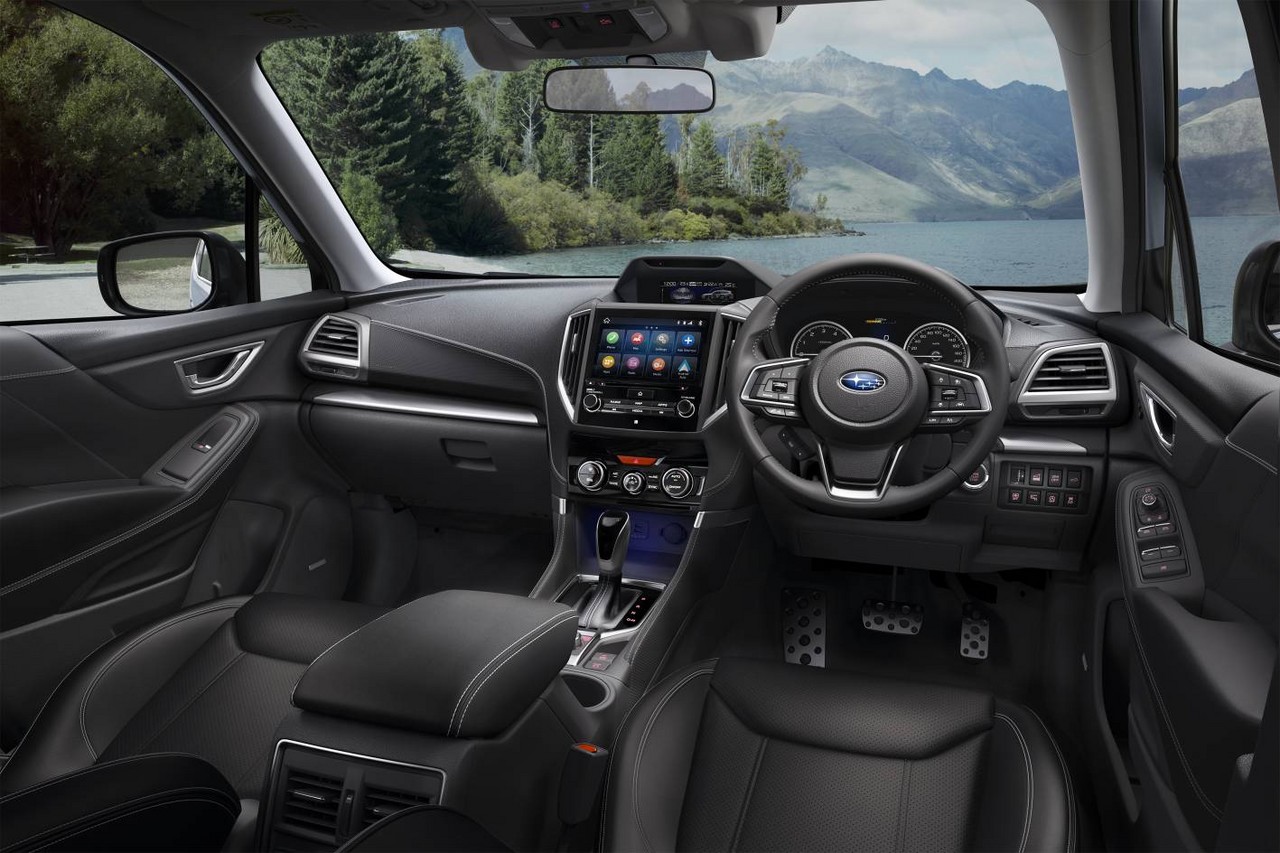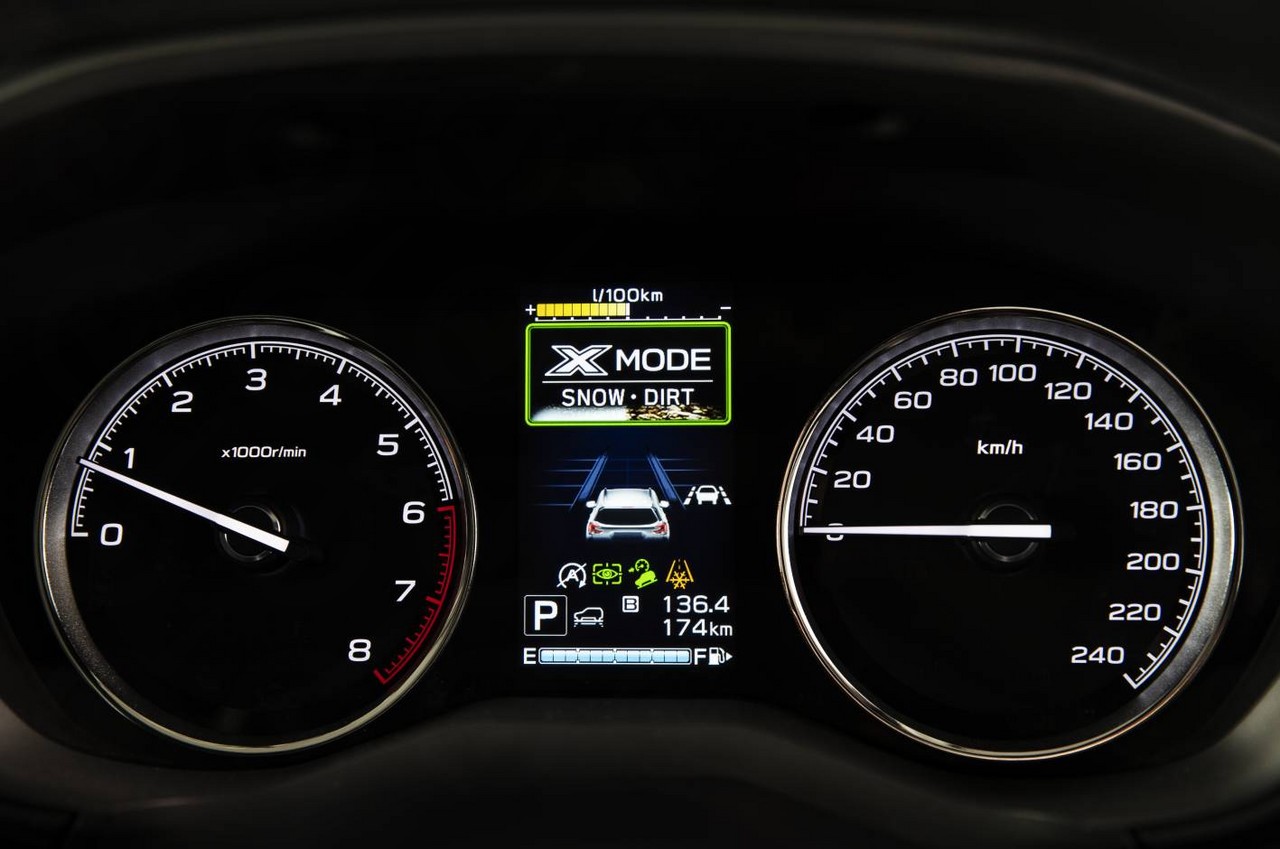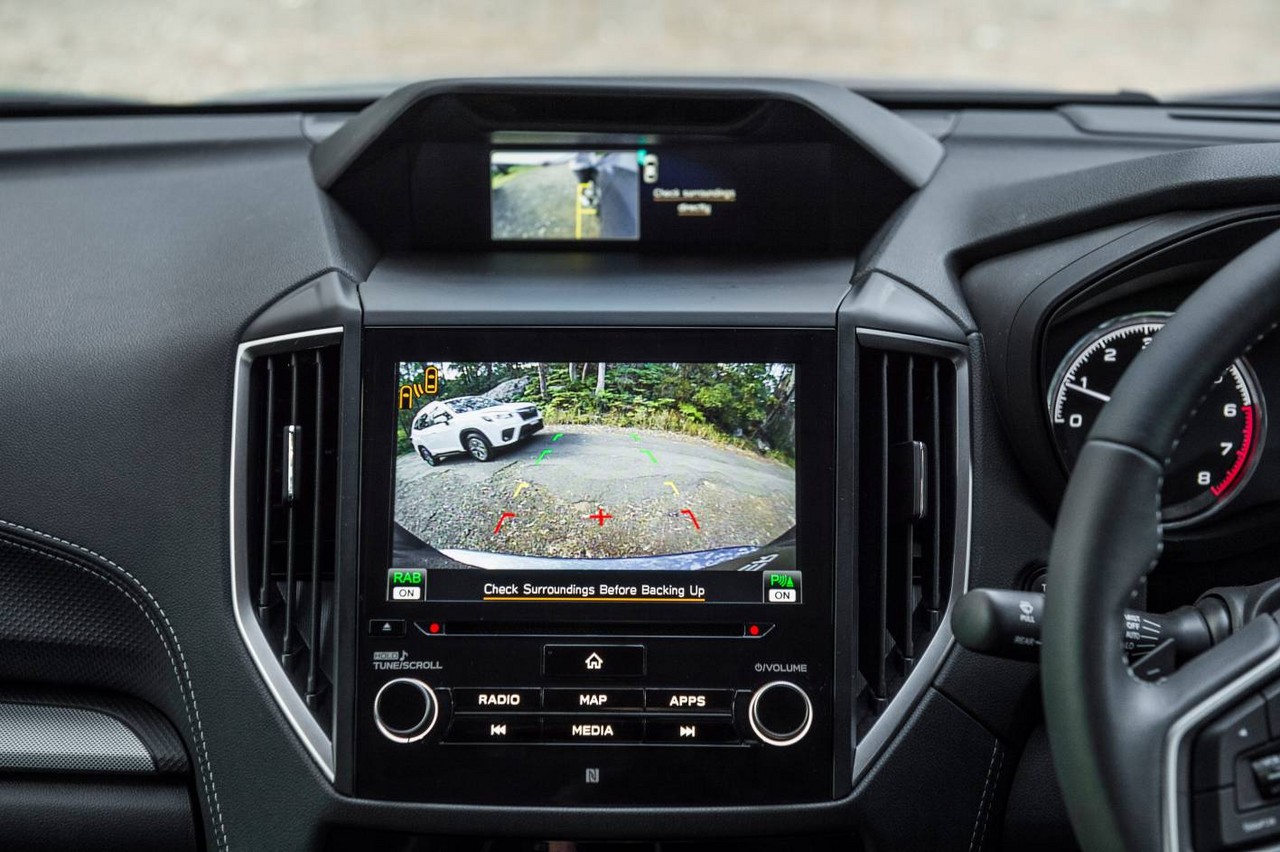
- Refined 2.5-litre petrol engine
- Traction from ‘Active Torque Split’ All-Wheel Drive System
- Generally comfortable ride
- Autonomous Emergency Braking (AEB) and Adaptive Cruise Control (ACC) fitted as standard
- Wide-opening rear doors
- Engine lacks pulling power of some rivals
- For front seats, lumbar support not adjustable
- Driver Monitoring System doesn’t always work as intended
- Noise from standard Bridgestone tyres
- Three year warranty shorter than rivals
Overview
Released in Australia in September 2018, the Subaru SK Forester was a mid-size SUV. Manufactured in Gunma, Japan, the all-wheel drive Subaru SK Forester was powered by a 2.5-litre four-cylinder petrol engine that was mated to a continuously variable transmission (CVT) that had seven pre-set ratios. As per the table below, the Subaru SK Forester range consisted of 2.5i, 2.5i-L, 2.5i Premium and 2.5i-S variants.
SK Forester: FB25 engine
The 2498 cc FB25 horizontally-opposed four-cylinder petrol engine had an aluminium block and head, double overhead camshafts (chain-driven), four valves per cylinder, Subaru’s Dual Active Valve Control System (AVCS, for variable intake and exhaust valve timing), direct injection and a compression ratio of 12.0:1. To reduce fuel consumption, the FB25 engine had an ‘Auto Stop/Start’ function which enabled it to automatically shut down when the vehicle was stationary in traffic and then restart when the driver removed their foot from the brake pedal.
The minimum fuel requirement for the FB25 engine was 91 RON unleaded petrol.
| Engine | Trans. | Peak power | Peak torque | |
|---|---|---|---|---|
| 2.5i, 2.5i-L, 2.5i Premium, 2.5i-S |
2498 cc FB25 petrol F4 | CVT | 136 kW at 5800 rpm | 239 Nm at 4400 rpm |
Active Torque Split AWD system
For the Subaru SK Forester, the all-wheel drive system utilised an electronically-controlled multi-plate transfer clutch (Subaru’s ‘Active Torque Split’ system). The system provided a default front:rear torque split of 60:40 in normal conditions, though additional torque could be sent to the rear wheels if slip was detected at the front wheels.
The Subaru Forester was also equipped with Subaru’s ‘X-Mode’ which provided ‘integrated control of engine, AWD, braking, and other functions’ at speeds of 40 km/h or less to enhance driving performance on poor roads or slippery surfaces. At speeds below 40 km/h, X-Mode had the following effects:
- At low engine loads, the throttle would open more slowly to avoid sudden torque changes;
- For the traction control unit, AWD clutch pressure was increased by around 25 per cent to better control differential rotation between the front and rear wheels; and,
- Enhanced limited slip differential (LSD) control would counteract differential rotation between left and right wheels by accelerating brake boosting speed and delaying reduction of brake pressure when wheel rotation returned to normal.
At speeds below 20 km/h, Hill Descent Control (HDC) could be used to control the brakes on steep hills to maintain vehicle speed without any action required from the driver. HDC was automatically activated if speed was increasing on a descent, resulting in constant speed.
Body and dimensions
The Subaru SK Forester was underpinned by the ‘Subaru Global Platform’ (SGP) which was shared with the Subaru GK/GT Impreza and Subaru GT XV . Compared to the Subaru SJ Forester which it replaced, the SK Forester was 30 mm longer (4625 mm), 20 mm wider (1815 mm), 5 mm lower (1730 mm) and had a 30 mm longer wheelbase; ground clearance was 220 mm. Luggage space for SK Forester was 498 litres (VDA method), though this increase to 1768 litres when the rear seats were folded down and luggage was filled to the roofline.
Suspension and steering
The Subaru SK Forester had MacPherson strut front suspension (with lower L-arms, coil springs and a stabiliser bar) and double wishbone rear suspension. Furthermore, the SK Forester had rack-and-pinion steering with electric power assistance; its minimum turning circle was 10.8 metres.
Safety equipment
Standard safety equipment for the Subaru SK Forester included dual front airbags, a driver’s knee airbag, front seat-mounted side airbags, full-length curtain airbags, ABS, electronic brake force distribution, brake assist, electronic stability control, traction control and front seatbelts with pre-tensioners and load limiters.
As standard, the SK Forester was equipped with Subaru’s ‘EyeSight’ Driver Assist system which included the following technologies –
- Pre-collision throttle management: where there was a risk of collision with the vehicle ahead, pre-collision throttle management would reduce available acceleration;
- Pre-Collision Braking Assist: could prime the braking system for more rapid deceleration when the brake pedal was depressed or autonomous braking activated;
- Pre-Collision Braking: monitored the distance to objects ahead could detect if a collision was imminent, provided the relative speed difference of the vehicle ahead was less than 50 km/h. If detected, the brakes would be applied to avoid or minimise the severity of the collision (also known as ‘Autonomous Emergency Braking’, or AEB);
- Adaptive Cruise Control (ACC): could maintain a safe distance from the vehicle ahead by braking, or accelerate up to the driver-selected target speed where safe to do so. ACC could operate at speeds up to 145 km/h and could detect illumination of the brake lights of the vehicle ahead for smoother deceleration and acceleration;
- Brake light recognition: could detect if the brake lights of the vehicle ahead were illuminated – this could provide earlier detection of a collision hazard.
- Lane Departure Warning (LDW): operating at speeds above 60 km/h, LDW used the camera to detect lane markings and determine if the vehicle was about to drift outside its lane. If this occurred, the driver would be alerted by an audible warning;
- Lane Keep Assist (LKA): operating at speeds above 60 km/h, LKA would provide corrective steering assistance to keep the vehicle in its lane if it was about to drift outside of it;
- Lane-sway warning: at speeds above 60 km/h, vehicle sway (or drift) was monitored and, if detected, a warning message and tone was issued. Vehicle sway could result from driver fatigue, inattentive driving or cross-winds;
- Lead Vehicle Start Alert: if an obstacle was detected in front of the vehicle, sudden movement or unintended depression of the accelerator would be restricted. A warning display and sound would also be activated; and,
- A Speed Limiter.
As standard, the SK Forester was also equipped with Subaru’s ‘Vision Assist’ technologies which included –
- Blind Spot Detection (BSD): could detect if another vehicle was in the driver’s blind spot and, if so, illuminated an icon in the door mirror. If the driver then applied the indicators to change into that lane, the icon would flash to warn the driver;
- Lane Change Assist (LCA): could detect if a vehicle in an adjacent lane was approaching from behind and would flash the icon in the door mirror on that side of the Forester to warn the driver;
- Rear Cross Traffic Alert (RCTA): could detect oncoming vehicles that may cross the XV’s path if it were to reverse from a parking space, and warn the driver by flashing the icon in the applicable door mirror; and,
- EyeSight Assist Monitor: could display warning on the lower windscreen.
For the SK Forester 2.5i-L, 2.5i Premium and 2.5i-S, ‘Vision Assist’ was extended to include:
- Adaptive Driving Beam (ADB): headlights that would automatically 1) switch between high and low beams, and 2) mask their illumination to avoid dazzling other drivers;
- Reverse Automatic Braking (RAB): when reversing at speeds up to 15 km/h, Reverse Automatic Braking used four sonar sensors mounted in the rear bumper to detect objects up to 1.5 metres behind the vehicle and over a width 15 centimetres greater than the rear bumper on each side. Initially, the driver would receive an audible warning if there was a collision risk, followed by a reduction in engine power if a collision was assessed to be imminent. If the driver still did not apply the brakes, then emergency braking would be initiated;
- Front View Monitor (FVM): operating at speeds under 20 km/h, images from a front-mounted camera could be shown on the Multi-Function Display (MID). As such, the Front View Monitor enabled the driver to check for approaching vehicles or pedestrians at intersections with poor visibility; and,
- Side View Monitor (SVM): operating at speeds under 20 km/h, SVM used a camera in the passenger side mirror and showed – on the Multi-Function Display – the distance from the kerb (or a parked vehicle) when reversing into a parking space.
These variants were also equipped with Subaru’s ‘Driver Monitoring System’ which used facial recognition technology to monitor driver drowsiness or distraction and would issue alerts (audible and visual) if detected.
Wheels and tyres
The Subaru Forester 2.5i and 2.5i-L had 17 x 7.0J tyres with 225/60 R17 Bridgestone 99V tyres. The Subaru Forester 2.5i Premium and 2.5i-S, however, had 18 x 7.0J tyres with 225/55 R18 Bridgestone 98V tyres.
Features: Subaru SK Forester 2.5i
The standard infotainment system for the Subaru SK Forester consisted of a 6.5-inch LCD touchscreen, a six speaker sound system with digital radio tuner (DAB+), CD player, Bluetooth mobile phone connectivity, voice recognition, Apple CarPlay and Android Auto smartphone integration, auxiliary (3.5 mm) and USB inputs, and two USB charge ports for rear passengers.
Other standard features for the Subaru SK Forester 2.5i included dual-zone climate control air conditioning, daytime LED running lights, front fog lights, directional LED headlights with dusk-sensing function, rain-sensing wipers, a rear view reverse camera, 60/40 split folding rear seats, remote central locking with proximity key (i.e. keyless entry), power adjustable and heated door mirrors with folding function, power windows, a height and reach adjustable steering wheel, a height adjustable driver’s seat, push-button start, an electronic parking brake, illuminated vanity mirrors, rear privacy glass, roof rails, tyre pressure monitoring, three 12 volt power jacks, a trip computer with a 4.2-inch LCD and an immobiliser.
Features: Subaru SK Forester 2.5i-L
Compared to the SK Forester 2.5i, the Forester 2.5i-L was further equipped with Subaru’s ‘Driver Monitoring System’ which enabled the driver to engage the last used climate control, Multi-Function Display and Multi-Information Display (MID) settings.
Features: Subaru SK Forester 2.5i Premium
Relative to the SK Forester 2.5i-L, the Forester 2.5i Premium added an eight-inch LCD touchscreen with a TomTom satellite navigation unit, ‘premium’ cloth seat trim, eight-way power adjustable front seats with driver memory settings, one touch power folding rear seats, auto-dipping passenger side mirror, auto-folding door mirrors, a powered rear tailgate, sports pedals and a ‘Subaru Intelligent Drive’ (SI-Drive) function which enabled the driver to select from Intelligent (I) and Sport (S) drive modes. The functionality of the Driver Monitoring System was also extended to include automatic adjustment of the driver’s seat and door mirrors according to previously used settings.
Visually, the Subaru SK Forester 2.5i Premium and 2.5i-S could be identified by their chrome window sill trims and tail pipe cover.
Features: Subaru SK Forester 2.5i-S
The range-topping Subaru SK Forester 2.5i-S was distinguished by its Harman Kardon sound system which had eight speakers and a subwoofer, leather seat trim (including synthetic leather parts), LED front fog lights and power-operated sunroof. Visually, the SK Forester 2.5i-S could be identified by its silver coloured door mirrors and silver inserts for the side cladding and roof rails.
Specifications
